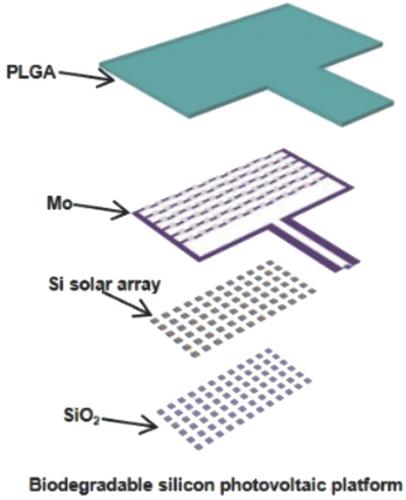当前位置:
X-MOL 学术
›
Adv. Energy Mater.
›
论文详情
Our official English website, www.x-mol.net, welcomes your feedback! (Note: you will need to create a separate account there.)
Biodegradable Monocrystalline Silicon Photovoltaic Microcells as Power Supplies for Transient Biomedical Implants
Advanced Energy Materials ( IF 27.8 ) Pub Date : 2018-02-16 , DOI: 10.1002/aenm.201703035 Luyao Lu 1, 2 , Zijian Yang 1 , Kathleen Meacham 3 , Caroline Cvetkovic 4 , Elise A. Corbin 4 , Abraham Vázquez-Guardado 5 , Mantian Xue 1 , Lan Yin 6 , Javaneh Boroumand 5 , Grace Pakeltis 1 , Tian Sang 1 , Ki Jun Yu 7 , Debashis Chanda 5 , Rashid Bashir 4 , Robert W. Gereau 3 , Xing Sheng 8 , John A. Rogers 9
Advanced Energy Materials ( IF 27.8 ) Pub Date : 2018-02-16 , DOI: 10.1002/aenm.201703035 Luyao Lu 1, 2 , Zijian Yang 1 , Kathleen Meacham 3 , Caroline Cvetkovic 4 , Elise A. Corbin 4 , Abraham Vázquez-Guardado 5 , Mantian Xue 1 , Lan Yin 6 , Javaneh Boroumand 5 , Grace Pakeltis 1 , Tian Sang 1 , Ki Jun Yu 7 , Debashis Chanda 5 , Rashid Bashir 4 , Robert W. Gereau 3 , Xing Sheng 8 , John A. Rogers 9
Affiliation

|
Bioresorbable electronic materials serve as foundations for implantable devices that provide active diagnostic or therapeutic function over a timeframe matched to a biological process, and then disappear within the body to avoid secondary surgical extraction. Approaches to power supply in these physically transient systems are critically important. This paper describes a fully biodegradable, monocrystalline silicon photovoltaic (PV) platform based on microscale cells (microcells) designed to operate at wavelengths with long penetration depths in biological tissues (red and near infrared wavelengths), such that external illumination can provide realistic levels of power. Systematic characterization and theoretical simulations of operation under porcine skin and fat establish a foundational understanding of these systems and their scalability. In vivo studies of a representative platform capable of generating ≈60 µW of electrical power under 4 mm of porcine skin and fat illustrate an ability to operate blue light‐emitting diodes (LEDs) as subdermal implants in rats for 3 d. Here, the PV system fully resorbs after 4 months. Histological analysis reveals that the degradation process introduces no inflammatory responses in the surrounding tissues. The results suggest the potential for using silicon photovoltaic microcells as bioresorbable power supplies for various transient biomedical implants.
中文翻译:

可生物降解的单晶硅光伏微电池作为瞬态生物医学植入物的电源
可生物吸收的电子材料是可植入设备的基础,可植入设备可在与生物过程相匹配的时间范围内提供主动的诊断或治疗功能,然后在体内消失,避免进行二次外科手术摘除。这些物理瞬态系统中的电源供应方法至关重要。本文介绍了一种基于微尺度电池(microcells)的完全可生物降解的单晶硅光伏(PV)平台,该平台设计用于在生物组织中具有长穿透深度的波长(红色和近红外波长)下工作,以便外部照明可提供逼真的水平力量。在猪皮和脂肪下操作的系统表征和理论模拟建立了对这些系统及其可扩展性的基础理解。在4 mm的猪皮和脂肪下能产生≈60µW电能的代表性平台的体内研究表明,该设备能够将蓝色发光二极管(LED)作为大鼠皮下植入物运行3 d。在这里,光伏系统在4个月后会完全吸收。组织学分析表明,降解过程在周围组织中未引起炎症反应。结果表明使用硅光伏微电池作为各种瞬态生物医学植入物的生物可吸收电源的潜力。组织学分析表明,降解过程在周围组织中未引起炎症反应。结果表明使用硅光伏微电池作为各种瞬态生物医学植入物的生物可吸收电源的潜力。组织学分析表明,降解过程在周围组织中未引起炎症反应。结果表明使用硅光伏微电池作为各种瞬态生物医学植入物的生物可吸收电源的潜力。
更新日期:2018-02-16
中文翻译:

可生物降解的单晶硅光伏微电池作为瞬态生物医学植入物的电源
可生物吸收的电子材料是可植入设备的基础,可植入设备可在与生物过程相匹配的时间范围内提供主动的诊断或治疗功能,然后在体内消失,避免进行二次外科手术摘除。这些物理瞬态系统中的电源供应方法至关重要。本文介绍了一种基于微尺度电池(microcells)的完全可生物降解的单晶硅光伏(PV)平台,该平台设计用于在生物组织中具有长穿透深度的波长(红色和近红外波长)下工作,以便外部照明可提供逼真的水平力量。在猪皮和脂肪下操作的系统表征和理论模拟建立了对这些系统及其可扩展性的基础理解。在4 mm的猪皮和脂肪下能产生≈60µW电能的代表性平台的体内研究表明,该设备能够将蓝色发光二极管(LED)作为大鼠皮下植入物运行3 d。在这里,光伏系统在4个月后会完全吸收。组织学分析表明,降解过程在周围组织中未引起炎症反应。结果表明使用硅光伏微电池作为各种瞬态生物医学植入物的生物可吸收电源的潜力。组织学分析表明,降解过程在周围组织中未引起炎症反应。结果表明使用硅光伏微电池作为各种瞬态生物医学植入物的生物可吸收电源的潜力。组织学分析表明,降解过程在周围组织中未引起炎症反应。结果表明使用硅光伏微电池作为各种瞬态生物医学植入物的生物可吸收电源的潜力。



























 京公网安备 11010802027423号
京公网安备 11010802027423号